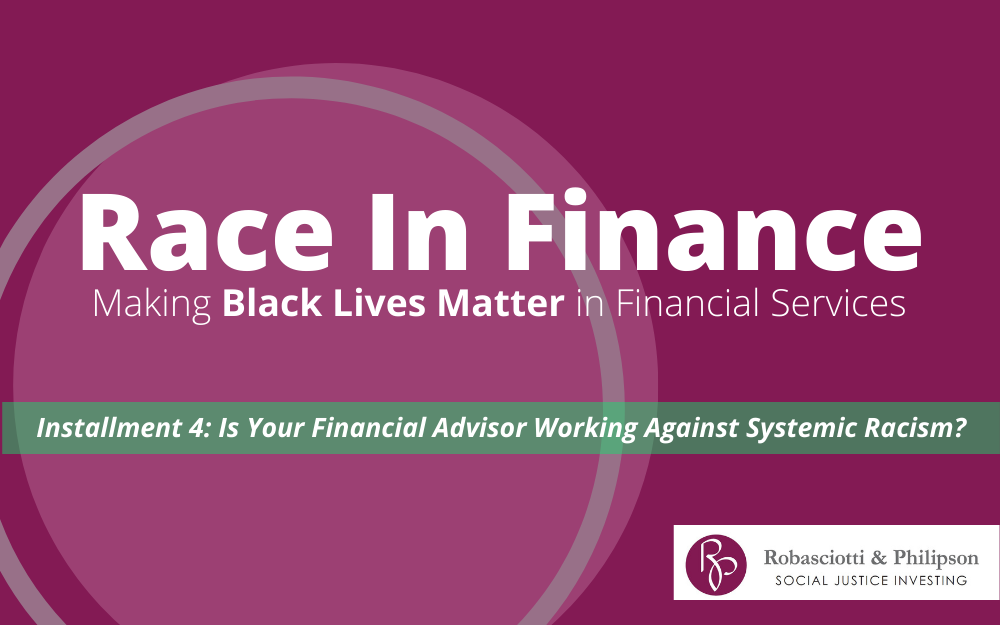
At Adasina, all of our work is done in community, including with communities inside of the investment and financial world. Today, I’m happy to showcase the work of two of our finance community members, Kamila McDonnough, MBA, CFP®, and Keith Beverly MBA, CFP®, CFA. Their firm, GRID 202 Partners, recently published a guide to selecting a financial advisor; this guide complements our work at Adasina and we are honored to include an excerpt in our Race In Finance series.
Many of our Race In Finance readers are financial services professionals, and we hope you’ll think about the answers your firm would give to these questions. If you find the questions challenging to answer, consider that this might mean you are missing out on both Black professional talent, and Black clients and prospects. May this be an opportunity to strengthen your business and our community.
– Rachel J. Robasciotti
—
A Racial Equity-Centered Approach to Choosing a Financial Advisor: 7 Questions to Ask
By: Kamila McDonnough and Keith Beverly, Grid 202 Partners
Selecting the right advisor among the crowd of nearly 300,000 in the United States is daunting. Beyond reviewing the basics: credentials, work experience, whether the advisor is a fiduciary (and what that means!), and compensation arrangements, there are a host of other factors you may want to consider. That’s especially true if you want to incorporate racial diversity, whether in your portfolio or your advisor selection process.
In an industry where only 3.8% (3,259 of more than 87,000) of Certified Financial Planner professionals are Black or Latinx1, those for whom racial equity is an imperative must be intentional in their process of selecting a new advisor or evaluating their current one. Our questions below are meant as a guide to including racial equity and/or firm diversity as criteria for selecting an advisor.
Question 1: What percentage of your advisors are BIPOC (Black, Indigenous, and other People of Color)?
Diverse representation matters. Empirical research on diversity and financial performance shows companies with more racial and gender diversity in their leadership teams perform better than do more homogenous firms. Despite the compelling evidence, one recent study showed only 0.5% of advisors at independent RIA firms are African-American2. For smaller firms, you can simply visit the “About Us” or “Our Team” pages on their website to see the team’s racial diversity. Larger firms (over 100 employees) must provide this information to the federal government, but are not required to disclose it publicly. To find out where they stand, you may want to request their EEOC data.
Question 2: Does your firm have a statement or policy regarding diversity, equity, and inclusion?
Many companies issue statements proclaiming their commitment to diversity, equity and inclusion. Rarely do firms follow through with tangible actions they consistently measure. Reviewing a firm’s statement and seeing how it is reflected (or not) in the firm’s hiring practices, business, and investment functions will give you a clearer picture of the depth of its commitment.
Question 3: What percentage of your current assets under management are managed by firms with majority ownership by Black, Indigenous, and other People of Color?
A recent study from the Knight Foundation found that only 1.3% of the $69 trillion in global investment assets are managed by diverse and woman-owned asset management firms3. However, a recent study from Harvard Business School and Bella Research Group4 found “there is no statistical difference in performance between diverse-owned firms and their peers.” That means clients who prioritize diversity and achieving returns, do not have to choose between investing in line with their values and firms with no diverse representation. GRID has built strong relationships with diverse managers across both public and private markets. We increasingly find appropriate opportunities to entrust client assets with these managers—all of whom have demonstrated an ability to consistently outperform their respective benchmarks.
Questions 4-7: To read all 7 questions, please read the full report here.
About the authors
Kamila McDonnough, MBA, CFP®, and Keith Beverly MBA, CFP®, CFA are partners of GRID 202 Partners, a registered investment advisory firm that serves both individual investors and institutions with a special interest in ensuring client investment assets align with their social and moral values.
To read future installments of this series, sign up for our newsletter or follow #RaceInFinance conversation on social media.
- Tobias Salinger, “How many Black planners? CFP Board will answer upon request,” Financial Planning, (June 3, 2020).
- Kenneth White, Megan McCoy,Kim Love, et all, “The Role of Signaling When Promoting Diversity and Inclusion at the Firm Level: A Financial Advisory Professional Case Study,” Advances in Business Research, (2019).
- Knight Foundation, “Diverse Asset Managers: Opportunities for Inclusion,” Knight Foundation, (June 25, 2019).
- Bella Research Group, “Diversifying Investments: A Study of Ownership Diversity and Performance in the Asset Management Industry,” KF, (January 2019).